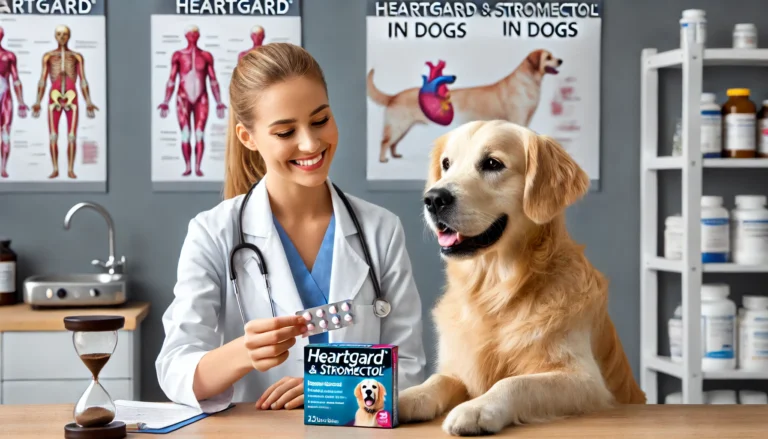liver disease in dogs

Liver disease in dogs is a serious and potentially life-threatening condition that requires prompt recognition, diagnosis, and management. The liver plays a vital role in many physiological processes, including detoxification, metabolism, protein synthesis, and bile production. When the liver becomes diseased, it can no longer perform these functions effectively, leading to a wide range of health issues. This guide aims to provide dog owners with a comprehensive understanding of liver disease in dogs, covering everything from causes and symptoms to diagnosis, treatment, and prevention.
1. Understanding the Liver’s Function
The liver is one of the most important organs in your dog’s body. Located in the abdomen, it performs numerous functions essential for survival, including:
- Metabolism of Nutrients: The liver processes proteins, fats, and carbohydrates that the dog consumes.
- Detoxification: The liver breaks down toxins and harmful substances, removing them from the bloodstream.
- Protein Synthesis: It synthesizes proteins that are critical for various bodily functions, including clotting factors for blood.
- Storage of Energy: The liver stores glycogen, which can be converted into glucose when needed.
- Bile Production: The liver produces bile, a substance that helps with fat digestion.
Given the liver’s central role in maintaining the dog’s overall health, liver disease can have wide-ranging and severe consequences.
2. Types of Liver Disease in Dogs
There are several different types of liver disease, each with its unique causes, symptoms, and treatment options. Some of the most common forms of liver disease in dogs include:

2.1. Hepatitis (Inflammation of the Liver)
Hepatitis is the inflammation of the liver tissue, often caused by infection, toxins, or autoimmune reactions. It can be acute (sudden onset) or chronic (long-lasting).
- Acute Hepatitis: This type usually occurs suddenly and can be caused by bacterial or viral infections, toxins, or certain medications.
- Chronic Hepatitis: Chronic hepatitis develops over time and is often the result of long-term liver damage, which can be caused by immune-mediated diseases, toxins, or infections.
2.2. Hepatic Lipidosis (Fatty Liver Disease)
Hepatic lipidosis occurs when there is an accumulation of fat in the liver cells. This condition is often seen in dogs with obesity, diabetes, or certain hormonal imbalances. It can be primary (not associated with any other disease) or secondary to another condition.
2.3. Cirrhosis
Cirrhosis is the progressive scarring of the liver tissue, often as a result of chronic liver disease. Over time, the liver becomes unable to function properly, leading to complications such as ascites (fluid buildup), bleeding disorders, and liver failure.
2.4. Liver Tumors
Liver tumors can be either benign (non-cancerous) or malignant (cancerous). Hepatic neoplasia, which refers to the development of tumors in the liver, is less common in dogs but can occur, especially in older pets.
2.5. Portosystemic Shunt (PSS)
A portosystemic shunt occurs when there is an abnormal blood vessel that bypasses the liver, causing toxins to accumulate in the bloodstream. This can lead to neurological symptoms and other systemic issues.
2.6. Copper Storage Hepatopathy
Copper storage disease is a hereditary condition, particularly seen in Bedlington Terriers, in which excessive copper accumulates in the liver. The buildup of copper damages liver cells and leads to liver dysfunction.
3. Causes of Liver Disease in Dogs
Liver disease in dogs can arise from a variety of causes. Some of the most common include:
- Infections: Bacterial, viral, or parasitic infections can cause liver inflammation.
- Toxins: Certain toxins, including medications, chemicals, and foods, can damage the liver. For example, acetaminophen (Tylenol) is toxic to dogs.
- Poor Diet: An unbalanced diet, including too much fat or insufficient protein, can contribute to liver problems.
- Genetic Factors: Some breeds are more predisposed to liver disease, particularly conditions like copper storage hepatopathy.
- Obesity: Excess fat in the body can accumulate in the liver, leading to hepatic lipidosis.
- Autoimmune Diseases: The dog’s immune system may mistakenly attack liver cells, causing chronic inflammation.
- Cancer: Tumors, either primary or secondary (metastatic), can also affect the liver.
4. Symptoms of Liver Disease in Dogs
Liver disease can present with a wide range of symptoms, depending on the severity and type of liver disorder. Some of the most common signs include:
4.1. General Symptoms
- Loss of Appetite: Dogs with liver disease may show a lack of interest in food.
- Weight Loss: Due to a reduced appetite and poor liver function, dogs may lose weight.
- Vomiting and Diarrhea: These are common gastrointestinal symptoms of liver disease.
- Lethargy: A dog suffering from liver disease may become tired and lethargic.
- Abdominal Pain: Liver enlargement can cause discomfort, leading to a swollen or tender abdomen.
4.2. Specific Symptoms
- Jaundice (Yellowing of the Skin or Eyes): The buildup of bilirubin in the bloodstream can cause yellowing of the gums, eyes, or skin.
- Excessive Thirst and Urination: A common sign of liver disease is increased thirst and frequent urination.
- Behavioral Changes: Liver disease can affect the brain, leading to confusion, depression, or even seizures.
- Bleeding or Bruising: Since the liver produces clotting factors, dogs with liver disease may have trouble stopping bleeding, leading to bruising or prolonged bleeding after cuts.
5. Diagnosing Liver Disease in Dogs
If liver disease is suspected, a veterinarian will perform several diagnostic tests to confirm the diagnosis and identify the underlying cause.
Do you know?
Dogs may sense their declining health through changes in their body, behavior, and energy levels, often becoming more withdrawn or seeking comfort from their owners. While they may not understand death in human terms, many dogs seem to intuitively know when something is wrong and respond accordingly.
5.1. Physical Examination
The vet will perform a thorough physical examination, looking for signs such as jaundice, a swollen abdomen (ascites), or other abnormalities. Palpating the abdomen may help detect liver enlargement.
5.2. Blood Tests
- Liver Enzyme Levels: Elevated levels of liver enzymes such as ALT (alanine aminotransferase) and AST (aspartate aminotransferase) are indicative of liver damage.
- Bilirubin Levels: High bilirubin levels can indicate liver dysfunction or hemolysis (destruction of red blood cells).
- Albumin and Protein Levels: Low albumin levels can suggest liver failure.
5.3. Imaging Tests
- Ultrasound: An abdominal ultrasound can provide detailed images of the liver, helping to identify tumors, cysts, or signs of cirrhosis.
- X-rays: These can help identify liver enlargement or fluid accumulation in the abdomen.
5.4. Biopsy
In some cases, a liver biopsy may be necessary to confirm the type of liver disease and determine its severity. A small tissue sample is taken from the liver and examined under a microscope.
6. Treatment Options for Liver Disease in Dogs
Treatment for liver disease in dogs depends on the underlying cause and the severity of the disease. In general, treatment options may include:
6.1. Medication
- Antibiotics: For bacterial infections causing liver inflammation.
- Steroids: Used for autoimmune liver diseases to reduce inflammation.
- Ursodeoxycholic Acid (UDCA): A bile acid that helps improve liver function in certain conditions.
- Vitamin K: To help treat clotting disorders caused by liver disease.
6.2. Diet
A special liver-friendly diet can help manage liver disease. These diets are typically low in fat and protein but contain easily digestible nutrients. In some cases, supplemental vitamins and minerals are required.
6.3. Surgery
- Tumor Removal: If liver tumors are identified, surgery may be necessary to remove them.
- Portosystemic Shunt Surgery: If a PSS is diagnosed, surgical correction can be done to reroute blood flow back to the liver.
6.4. Liver Transplant
In rare cases of severe liver failure, a liver transplant may be considered, though this is complex and not widely available.
7. Prognosis
The prognosis for a dog with liver disease depends on the type of liver disease, the severity of the condition, and how early it is diagnosed and treated. Early intervention and appropriate management can significantly improve the quality of life for dogs with liver disease. However, some forms of liver disease, such as cirrhosis or liver cancer, have a more guarded prognosis.
8. Preventing Liver Disease in Dogs
While not all forms of liver disease are preventable, certain steps can be taken to reduce the risk:
- Regular Veterinary Checkups: Annual or bi-annual veterinary exams can help detect early signs of liver disease.
- Healthy Diet and Weight: Feeding your dog a balanced, high-quality diet and managing their weight can help prevent obesity-related liver conditions.
- Toxin Prevention: Ensure your dog avoids exposure to toxic substances, including certain medications, foods (like chocolate or grapes), and chemicals.
- Genetic Screening: For breeds at risk of hereditary liver diseases, such as Bedlington Terriers with copper storage hepatopathy, genetic testing and early monitoring are crucial.
9. Conclusion: Liver disease in dogs
Liver disease in dogs is a complex and potentially life-threatening condition, but with early detection, appropriate treatment, and careful management, many dogs can lead healthy lives despite their liver issues. If you notice any of the symptoms of liver disease in your dog, it’s crucial to consult a veterinarian as soon as possible. Regular veterinary checkups and maintaining a healthy lifestyle for your dog can go a long way in preventing liver disease and promoting long-term health.
1. What are symptoms of liver disease in dogs?
Symptoms of liver disease in dogs can vary depending on the severity and type of condition but often include:
Loss of appetite and weight loss
Vomiting and diarrhea
Jaundice (yellowing of the skin, eyes, or gums)
Increased thirst and urination
Lethargy and reduced activity levels
Abdominal pain or bloating
Behavioral changes such as confusion or disorientation
Bruising or excessive bleeding (due to clotting issues)
If your dog shows any of these signs, it’s important to consult a veterinarian for proper diagnosis and treatment.
2. Can a dog recover from liver disease?
Yes, dogs can recover from liver disease, but recovery largely depends on the type of liver disease, the severity, and how early the condition is detected. Acute conditions like infections or toxin exposure may be treated effectively with medications and supportive care. Chronic conditions like cirrhosis or severe liver damage may not be fully reversible, but with appropriate management, such as dietary changes, medications, and regular monitoring, many dogs can lead comfortable lives. In cases of liver failure, treatment focuses on supportive care and managing symptoms to improve the dog’s quality of life.
3. How long can a dog live with liver disease?
The lifespan of a dog with liver disease depends on the underlying cause, the stage of the disease, and how well it is managed. If diagnosed early and treated properly, dogs can live for many years with liver disease. For example, a dog with mild hepatitis or a manageable condition like hepatic lipidosis may live for several years with appropriate care. However, severe liver failure, cirrhosis, or liver cancer can reduce lifespan, with life expectancy varying from a few months to a year, depending on the treatment response. Regular veterinary checkups and adherence to a prescribed care plan can improve life expectancy and quality of life.
4. What foods are bad for dogs’ liver?
Certain foods can worsen liver function or contribute to liver disease in dogs. Some of the most harmful foods for a dog’s liver include:
Toxic foods: Chocolate, grapes, raisins, onions, garlic, and certain nuts (like macadamia nuts) can cause liver damage.
Fatty foods: Excessive fat can lead to hepatic lipidosis (fatty liver disease).
Alcohol: Even small amounts of alcohol can be highly toxic to dogs.
High-sodium foods: Excessive salt can exacerbate conditions like liver failure, leading to fluid retention and increased strain on the liver.
Raw dough: Contains yeast that can ferment and produce alcohol in the stomach, which is toxic to the liver.
A balanced, vet-approved diet is essential to prevent liver damage and support healing if your dog has liver disease.
5. Is milk good for a dog’s liver?
Milk is generally not harmful to a dog’s liver in small amounts, but it should not be a regular part of their diet. Many adult dogs are lactose intolerant, meaning they have difficulty digesting dairy products, which can cause gastrointestinal upset like diarrhea or vomiting. Additionally, milk contains fats that could contribute to liver issues, particularly in dogs with pre-existing liver conditions. Always consult your vet before introducing milk or other dairy products into your dog’s diet.
6. Is banana good for the liver?
Bananas are generally safe for dogs and can be beneficial in moderation due to their high fiber content and potassium, which supports overall health, including liver function. While they aren’t a cure for liver disease, bananas are a healthy treat and can be included in the diet of a dog with liver problems as long as they are offered in moderation. Always consult your veterinarian before introducing new foods to your dog’s diet, especially if your dog has an existing liver condition.






